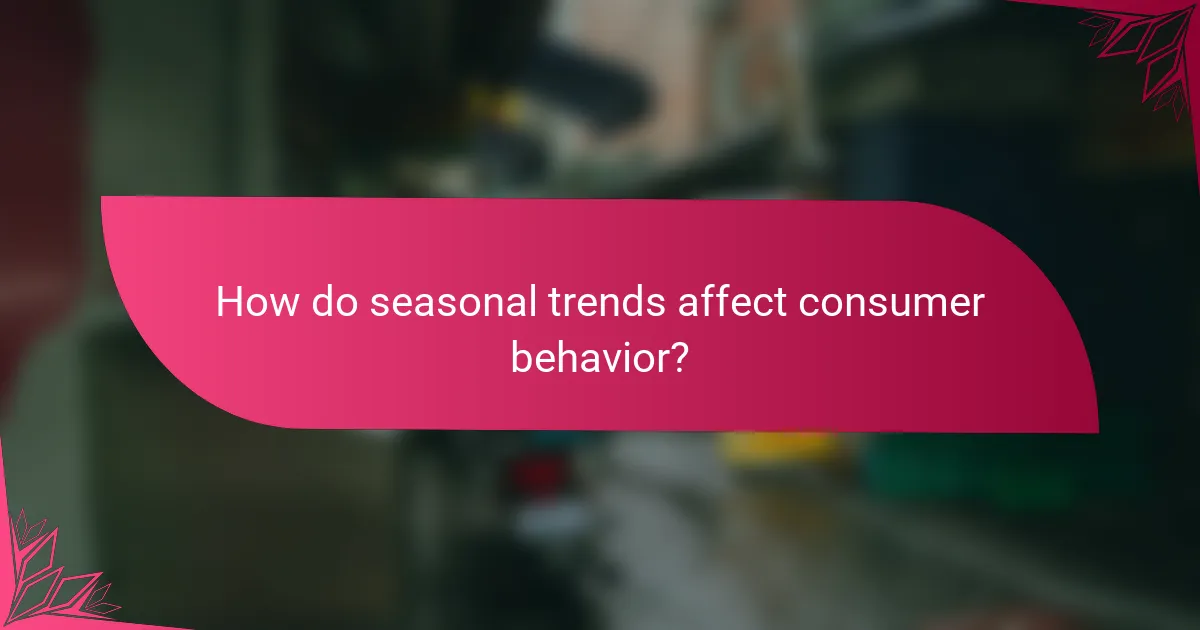Seasonal SEO campaigns are essential for US retailers aiming to enhance visibility and drive traffic during key shopping periods. By focusing on relevant keywords and local trends, retailers can tailor their content and marketing strategies to align with major events and holidays, ultimately influencing consumer behavior and purchasing patterns. Understanding these seasonal trends allows retailers to optimize their inventory and marketing efforts for maximum impact.

How can US retailers optimize seasonal SEO campaigns?
US retailers can optimize seasonal SEO campaigns by focusing on relevant keywords, local trends, and effective promotional strategies. Tailoring content and marketing efforts to align with seasonal events can significantly enhance visibility and drive traffic.
Target holiday-specific keywords
Identifying and using holiday-specific keywords is crucial for seasonal SEO. Retailers should research terms that customers are likely to search for during specific holidays, such as “Christmas gifts” or “Halloween costumes.” Tools like Google Keyword Planner can help in finding popular search phrases.
Incorporate these keywords naturally into website content, product descriptions, and blog posts. Aim for a mix of short-tail and long-tail keywords to capture a broader audience and improve rankings in search engine results.
Leverage local events and trends
Connecting seasonal campaigns with local events can enhance relevance and engagement. Retailers should monitor community calendars and social media to identify upcoming events that align with their products or services, such as local fairs or festivals.
Incorporating local keywords and themes into content can attract nearby customers. For example, a retailer might create a promotion around a local Thanksgiving parade, encouraging community participation and driving foot traffic.
Utilize seasonal content marketing
Creating seasonal content is an effective way to engage customers and improve SEO. Retailers can develop blog posts, guides, or videos that relate to the season, such as “Top 10 Summer BBQ Essentials” or “Winter Fashion Trends.”
Additionally, sharing this content on social media platforms can increase visibility and drive traffic back to the website. Seasonal content should be visually appealing and optimized for mobile devices to reach a wider audience.
Implement promotional strategies
Promotional strategies should align with seasonal campaigns to maximize impact. Retailers can offer discounts, bundle deals, or limited-time offers that resonate with the holiday spirit. For instance, a Valentine’s Day sale on gifts can attract couples looking to celebrate.
Utilizing email marketing to announce these promotions can also be effective. Segmenting email lists based on customer preferences can help tailor messages and increase conversion rates during the season.
Analyze competitor strategies
Understanding competitor strategies can provide valuable insights for optimizing seasonal SEO campaigns. Retailers should analyze competitors’ websites, social media, and promotional tactics to identify successful approaches and gaps in the market.
Tools like SEMrush or Ahrefs can help track competitors’ keyword rankings and backlink strategies. Learning from competitors can inform adjustments to one’s own campaigns, ensuring they remain competitive during peak seasons.

What are the key seasonal events for US retailers?
Key seasonal events for US retailers include major shopping days and holidays that significantly impact consumer spending. Understanding these events helps retailers plan effective marketing strategies and optimize their inventory for peak sales periods.
Black Friday
Black Friday, occurring the day after Thanksgiving, marks the unofficial start of the holiday shopping season. Retailers often offer substantial discounts, making it a crucial day for attracting customers both in-store and online.
To capitalize on Black Friday, retailers should prepare early by promoting deals through email marketing and social media. Consider creating a countdown to build anticipation and ensure that inventory levels meet expected demand.
Cyber Monday
Cyber Monday follows Black Friday and focuses on online shopping, with retailers offering exclusive online deals. This day has grown in importance as more consumers prefer to shop from home.
Retailers should optimize their websites for speed and mobile access to enhance the shopping experience. Highlighting limited-time offers can create urgency, encouraging customers to make quick purchases.
Christmas
Christmas is a peak shopping season, with consumers purchasing gifts, decorations, and festive items. The weeks leading up to Christmas are critical for retailers, as many shoppers finalize their purchases late in the season.
To maximize sales, retailers should offer gift guides and personalized recommendations. Free shipping and easy return policies can also attract more customers during this busy period.
Back to School
The Back to School season typically begins in late July and runs through early September, focusing on school supplies, clothing, and electronics. This period is particularly significant for retailers targeting families with school-aged children.
Retailers should consider bundling products, such as offering discounts on supplies when purchased with backpacks. Marketing campaigns should emphasize value and convenience, as parents often seek to save time and money.
Valentine’s Day
Valentine’s Day, celebrated on February 14, drives sales in categories like gifts, flowers, and dining. Retailers can benefit from this occasion by promoting romantic gifts and experiences.
Creating themed promotions and special offers can attract couples looking to celebrate. Consider offering gift bundles or discounts for early purchases to encourage shoppers to plan ahead.

How do seasonal trends affect consumer behavior?
Seasonal trends significantly influence consumer behavior by altering purchasing patterns and preferences throughout the year. Retailers must understand these trends to effectively align their marketing strategies and inventory with consumer expectations during peak shopping periods.
Increased online shopping
During seasonal events like holidays, consumers often turn to online shopping for convenience and better deals. Retailers should optimize their websites for mobile use and ensure a seamless checkout process to capture this surge in online traffic.
Consider implementing strategies such as targeted email campaigns and social media ads to attract online shoppers. Offering free shipping or easy returns can also enhance the online shopping experience and encourage purchases.
Shift in product demand
Seasonal trends lead to fluctuations in product demand, with certain items becoming more popular at specific times of the year. For example, retailers may see a spike in sales of winter apparel during colder months and outdoor gear in the summer.
To manage inventory effectively, retailers should analyze past sales data and forecast demand based on seasonal trends. This proactive approach helps prevent stockouts or excess inventory, which can impact profitability.
Heightened competition
Seasonal trends often intensify competition among retailers, as many businesses target the same consumer segments during peak shopping periods. This competition can lead to aggressive pricing strategies and promotional offers.
To stand out, retailers should focus on unique selling propositions, such as exclusive products or superior customer service. Building brand loyalty through consistent engagement can also help mitigate the effects of heightened competition.
Seasonal promotions impact
Seasonal promotions play a crucial role in driving consumer interest and boosting sales. Well-timed discounts and special offers can attract shoppers who are looking for deals during specific seasons.
Retailers should plan their promotional calendars in advance, aligning them with key shopping dates like Black Friday or back-to-school season. Utilizing email marketing and social media to announce promotions can maximize reach and effectiveness.

What tools can assist in seasonal SEO planning?
Several tools can significantly enhance seasonal SEO planning for US retailers by providing insights into trends, keyword performance, and content ideas. Utilizing these tools effectively can help optimize your campaigns to align with seasonal shopping behaviors.
Google Trends
Google Trends is a powerful tool that allows you to see the popularity of search queries over time. By analyzing seasonal trends, you can identify peak interest periods for specific keywords related to your products.
To leverage Google Trends, enter relevant keywords and filter results by region and time frame. This can help you anticipate when to ramp up your content and marketing efforts. For example, if you notice a spike in searches for “winter coats” starting in October, you can prepare your SEO strategy accordingly.
SEMrush
SEMrush offers a comprehensive suite of SEO tools, including keyword research, site audits, and competitive analysis. Its seasonal keyword tracking feature allows you to monitor how specific keywords perform during different times of the year.
Utilize SEMrush to create a content calendar based on keyword performance trends. For instance, if you find that “holiday gifts” sees increased search volume in late November, you can plan blog posts and product pages to target that traffic effectively.
Ahrefs
Ahrefs is renowned for its robust backlink analysis and keyword research capabilities. It can help you identify seasonal content opportunities by showing which topics are gaining traction in your niche.
To make the most of Ahrefs, analyze competitor content that performs well during specific seasons. This can guide your content creation efforts and help you identify gaps in your own strategy. For example, if competitors rank highly for “summer sales,” consider developing similar content with unique angles.
BuzzSumo
BuzzSumo specializes in content research and social media analytics, making it ideal for identifying trending topics and influencers. This tool can help you discover what types of seasonal content resonate with your audience.
Use BuzzSumo to find popular articles and posts related to your seasonal themes. By analyzing engagement metrics, you can tailor your content to match what is currently capturing attention. For example, if “back-to-school” articles are trending, consider creating guides or lists that align with that theme to attract more visitors.
